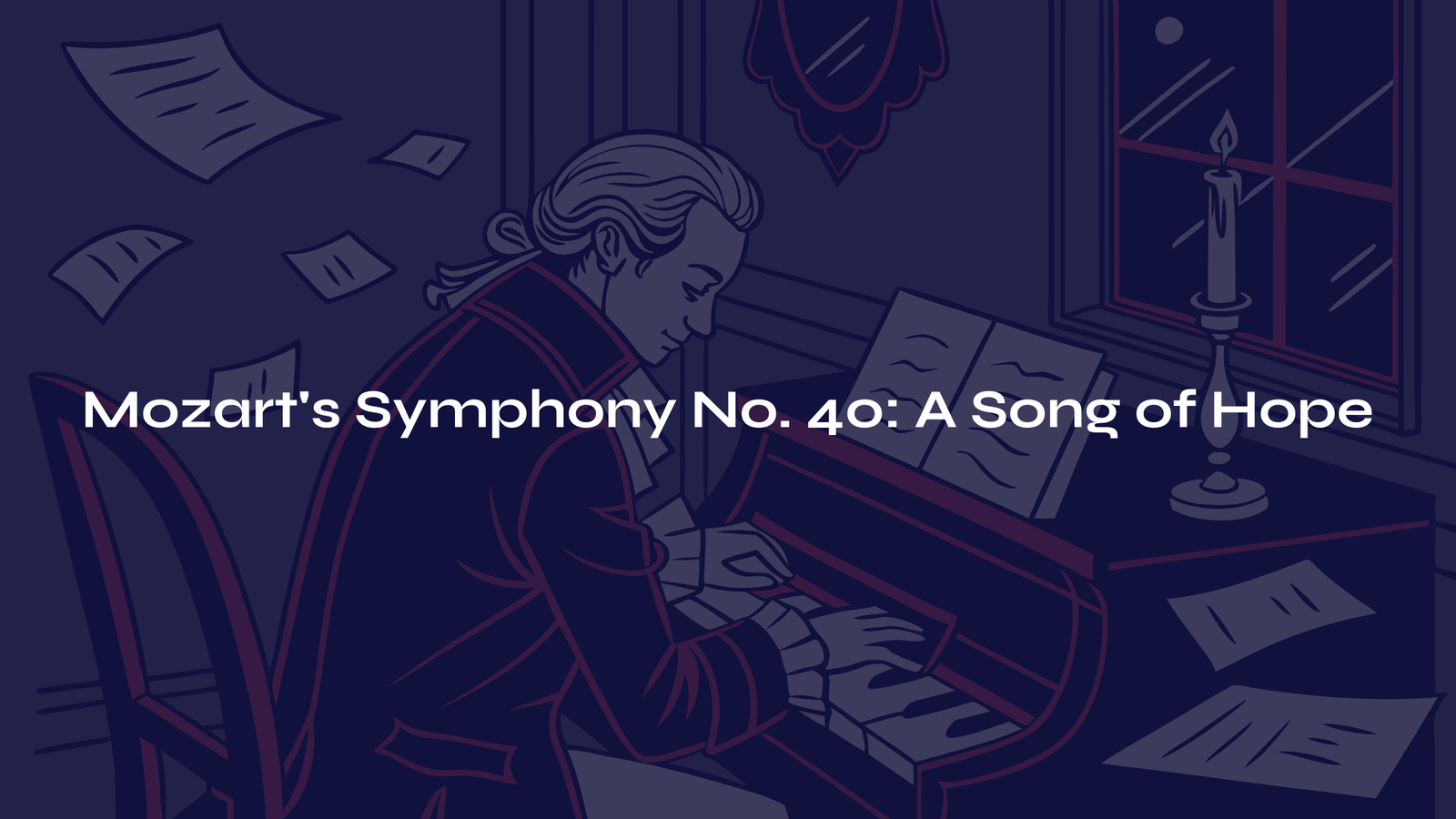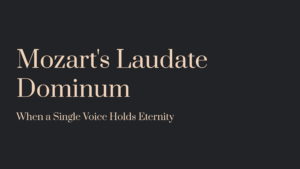Table of Contents
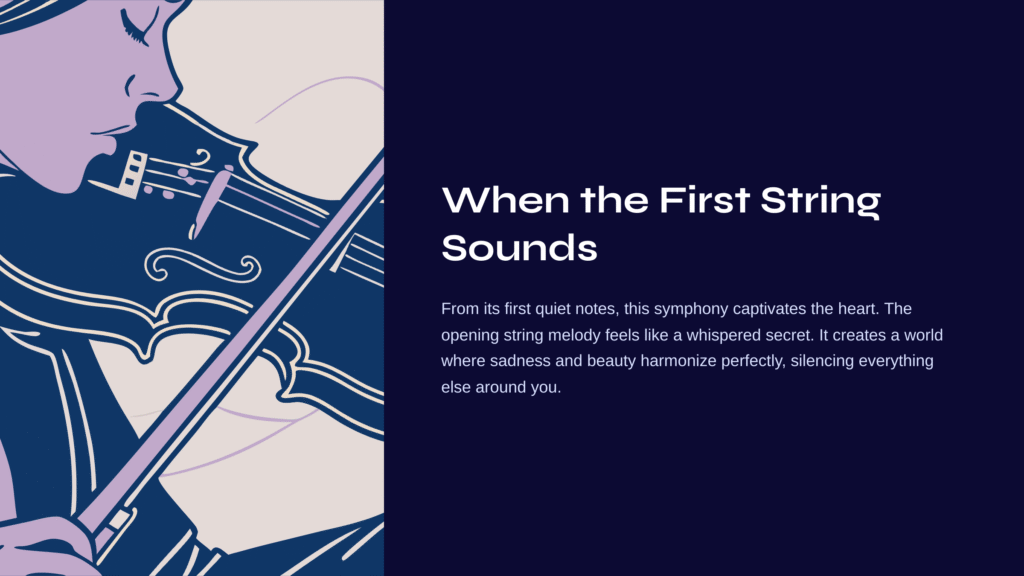
When the First String Sounds, Time Stands Still
Some music captures our hearts from the very first note. Mozart’s Symphony No. 40 in G minor is exactly that kind of piece. When you hear the quiet beginning of the string melody, it feels as if someone is whispering secrets in your ear. I still cannot forget the thrill I felt when I first heard this symphony.
It must have been an ordinary day, yet in that moment, all the noise of the world disappeared, and only that melody existed. Even within the dark tonality of G minor, there was something strangely warm to be felt. How can sadness and beauty harmonize so perfectly?
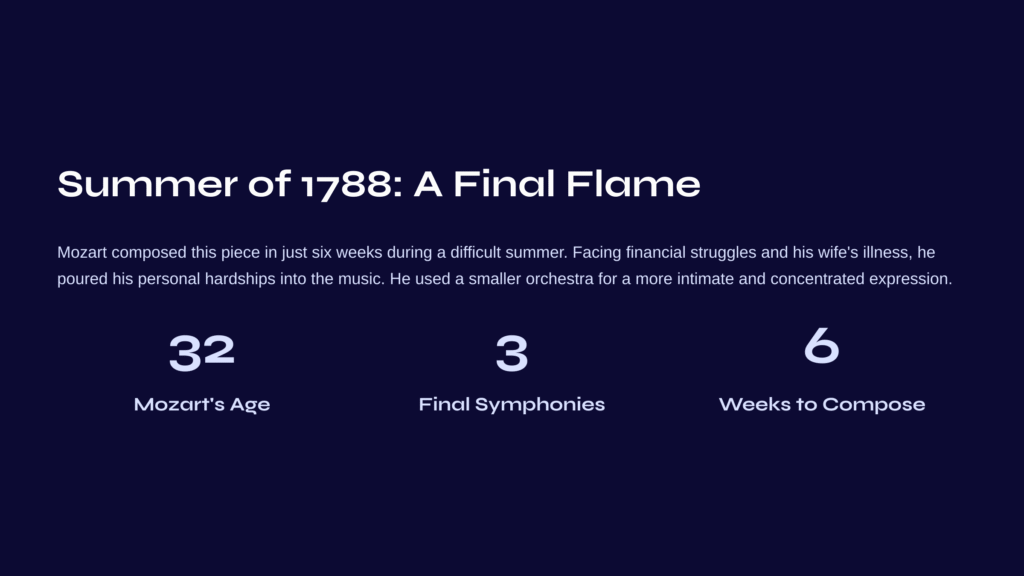
Summer of 1788: The Final Flame of Genius
Mozart composed this work in July 1788, when he was 32 years old and facing the last three years of his life. That summer was a time of miraculous creativity for Mozart. In just six weeks, he completed his final three symphonies (Nos. 39, 40, and 41).
At the time, Mozart was struggling with financial difficulties. He was gradually becoming alienated from Viennese aristocratic society, and his worries about his wife Constanze’s illness weighed heavily on him. These personal hardships are deeply embedded in this work. The key of G minor itself held special meaning for Mozart, as he composed very few pieces in this tonality throughout his entire oeuvre.
Interestingly, this symphony was written for a relatively small orchestra by the standards of the time. Excluding trumpets and timpani, it consists only of flute, oboes, bassoons, horns, and strings. Rather than pursuing brilliant sonorities, Mozart sought intimate and concentrated expression.
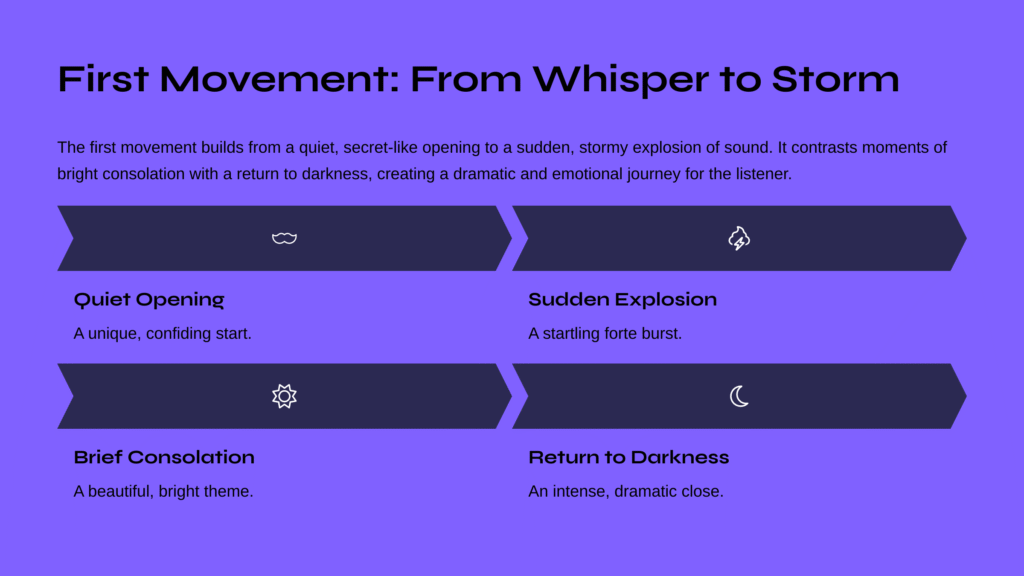
First Movement: From Whisper to Storm
The Calm Before the Tempest
The first movement begins in a truly unique way. Unlike most symphonies that open with bold and brilliant fanfares, this piece begins quietly, as if confiding a secret. When you hear the opening melody played by the violins, it feels like someone is revealing a story hidden deep in their heart.
This famous rhythmic pattern of two eighth notes and a quarter note becomes the crucial motif that runs through the entire movement. Though it appears simple, this small musical cell provides both tension and unity to the whole piece. Like a heartbeat, it repeats constantly, seeming to control our pulse.
The Moment of Sudden Change
The sudden forte explosion at measure 17 is truly startling. It’s like someone who was whispering suddenly bursts into a shout. At this moment, the music modulates to B-flat major, and the tension created by the descending violin melody against string tremolos feels like an approaching storm.
The Consolation of the Second Theme
The second theme that appears at measure 44 gives us momentary respite with the bright colors of B-flat major. The part where the strings first present the melody and the woodwinds repeat it with ornamental trills is truly beautiful. It feels like a ray of sunlight briefly appearing through the storm.
But this tranquility is short-lived. Soon we return to G minor and are drawn back into darkness. This contrast between light and shadow makes the piece even more dramatic.
Development Section: A Time of Musical Adventure
The development section beginning at measure 89 is truly thrilling. Using small fragments of the first theme, Mozart creates various transformations like a magician. Starting in F-sharp minor and traveling through various tonalities, it feels like embarking on an adventure.
In this section, Mozart freely employs chromatic harmony. The instability and tension created by melodies moving by semitones give a feeling of wandering through a labyrinth. Yet simultaneously, Mozart’s genius lies in never losing logical order within this complexity.
Recapitulation: The Return of Familiar Themes
The recapitulation beginning at measure 165 brings back familiar themes. But it’s not mere repetition. When the second theme is now played in G minor, it creates a completely different feeling. It’s like the same person appearing in different clothes.
Particularly impressive is the new material inserted from measure 198. The melody taken from the bridge section is newly varied, adding even richer expression to the piece.
Coda: To the Very Last Drop
The coda beginning at measure 211 is brief but intense. The alternation between dominant (D) and tonic (G minor) chords creates final tension. And when the piece finally ends with a perfect cadence, there’s a sense of relief, like returning home after a long journey.
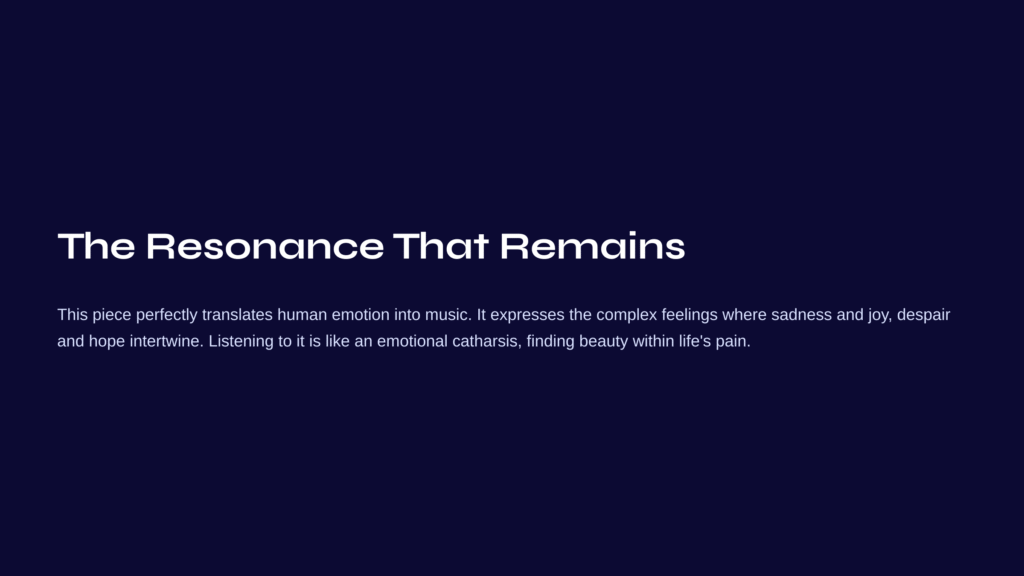
The Resonance That Remains in My Heart
What I feel every time I listen to this piece is that Mozart didn’t simply create beautiful melodies—he perfectly translated human emotion into music. The complex spectrum of feelings where sadness and joy, despair and hope interweave is expressed with such perfection.
Especially when I hear the quiet opening, my heart becomes solemn. It’s as if Mozart knows the secrets hidden deep in my heart. And at the suddenly explosive forte sections, my heart races, while the beautiful second theme warms my soul.
This piece is like an emotional catharsis for me. Without denying life’s difficulties and pain, I can feel Mozart’s wisdom in finding beauty within them.
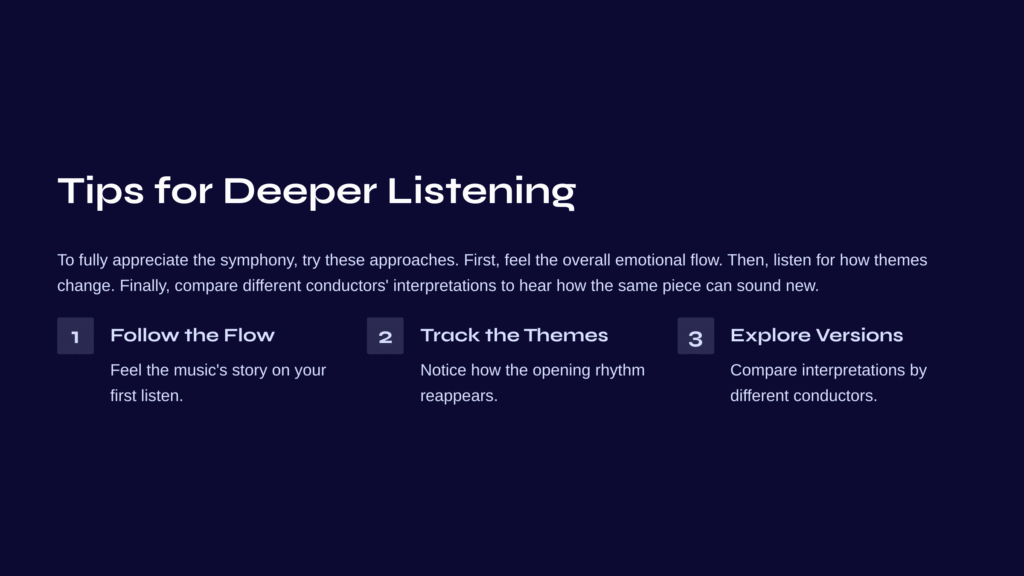
Small Tips for Deeper Listening
Focus on the Overall Flow When First Listening
If this is your first time hearing this piece, don’t worry about details—follow the overall emotional flow. Feel the contrast between the quiet beginning that gradually becomes intense, and the parts that become calm again. Like reading a novel, follow the story that the music tells.
Pay Attention to Thematic Changes on Second Listening
Once you’re familiar with it, listen for how the small rhythmic pattern (two eighth notes and a quarter note) that appears at the beginning is varied throughout the entire piece. It’s also interesting to compare how the same melody gives different feelings when played by different instruments.
Listen to Various Versions
This piece has been performed by many conductors with different interpretations. Comparing Karajan’s elegant version, Bernstein’s passionate version, and Harnoncourt’s dynamic version will amaze you at how differently the same piece can sound.
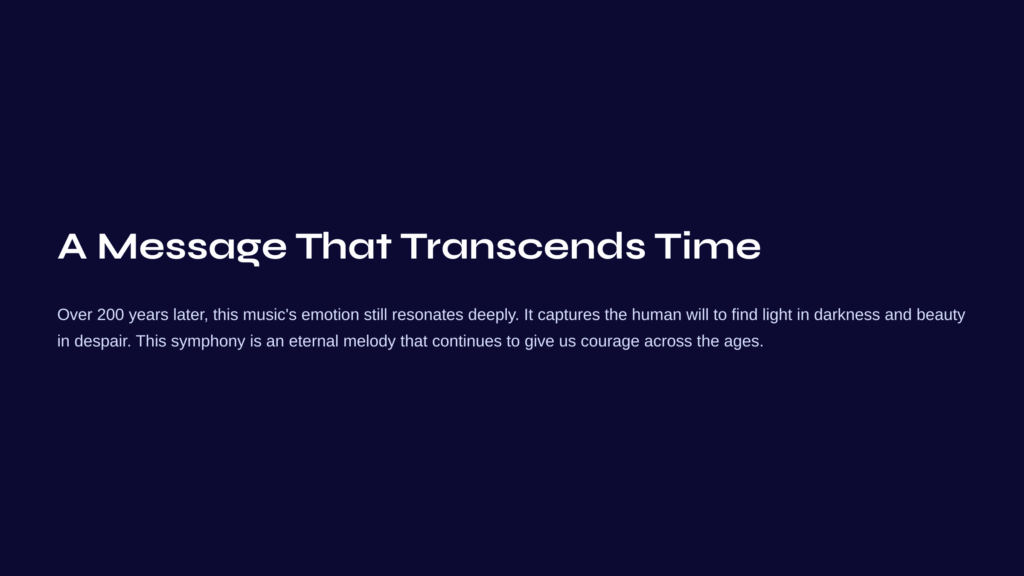
A Message That Transcends Time
More than 200 years have passed since Mozart composed this piece, but the emotion this music provides has not faded at all. In fact, it seems to deepen with time. Perhaps because human emotions transcend eras.
The human will that doesn’t lose light even in darkness, the artist’s soul that finds beauty even in despair—these are embedded completely in this piece. That’s why I gain courage every time I listen to it. Just as Mozart did, I believe we too can create melodies of hope in difficult moments.
This is why music transcends time. Art that completely contains one person’s true emotions always moves others’ hearts. Mozart’s Symphony No. 40 is such music. It’s an eternal melody that continues to resonate in our hearts across time.
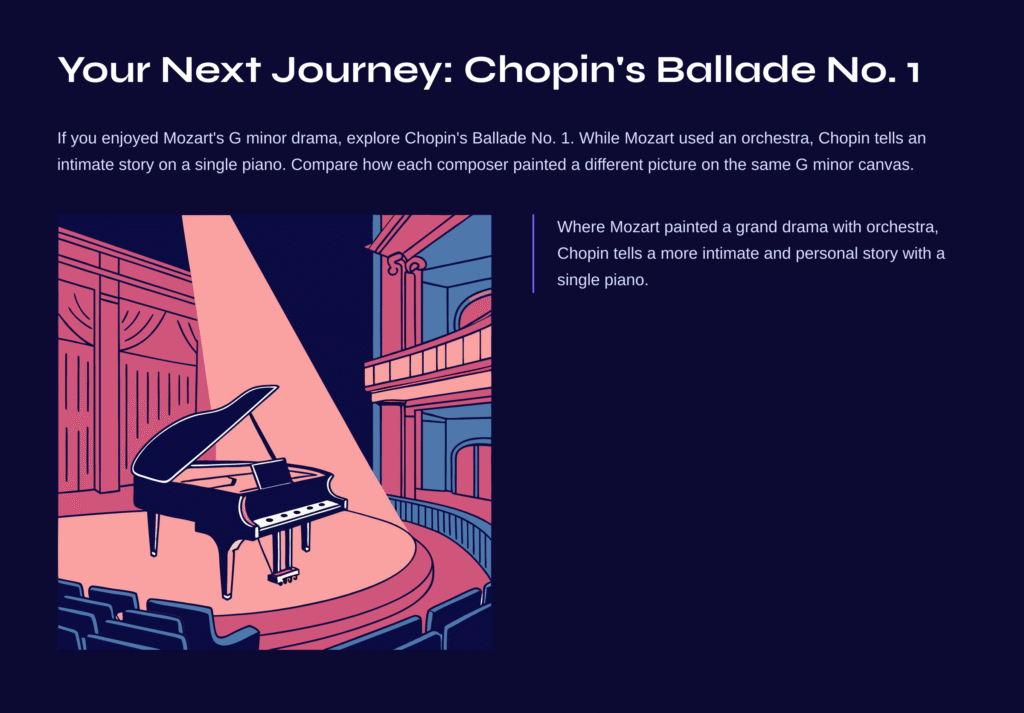
A Suggestion for Your Next Journey: Chopin’s Ballade No. 1 in G minor
If Mozart’s Symphony No. 40 has moved your heart with its deep resonance, how about embarking on a different kind of journey in G minor? I recommend Chopin’s Ballade No. 1 in G minor, Op. 23.
Though in the same G minor key, a completely different world unfolds. Where Mozart painted a grand drama with orchestra, Chopin tells a more intimate and personal story with a single piano. Private and sincere emotions flow out like secretly reading a friend’s diary.
The quietly beginning introduction has a curious resemblance to the opening of Mozart’s Symphony No. 40. But Chopin’s melody is more winding and unpredictable. It has the freedom of a poet improvising verses.
As you listen to this piece, compare how Mozart and Chopin each painted different pictures on the same canvas of G minor. You’ll discover new emotions at the meeting point where 18th-century Classical balance meets 19th-century Romantic freedom.
